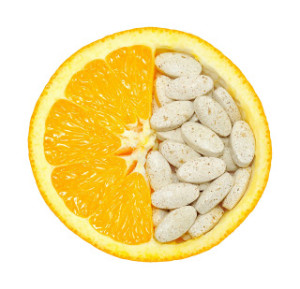
I grew up in California. Oceanside, to be specific.
… Okay, that’s a lie. I actually grew up in Vista, a landlocked hovel about 10 miles outside Oceanside. According to my parents, it was a positively awful neighborhood—full of violence, unearthly screams during the night, and definitely no place to raise a child.
That’s why, every week, my mom would drive six hours up the coast to Santa Barbara—the retirement and surfing haven—so I could stay with my grandparents.
During this weekly drive she would always snack on baby carrots. By the time she got there, almost three hours later, she’d be orange. You probably know why… because it’s easy to crunch down an entire pound of baby carrots when you’re focused on driving.
… But it’s mostly because beta-carotene is a fat-soluble nutrient, meaning if you take in more than your body needs, it’s stored in your fat cells for later use.
Now, if my mom had been snacking on bell peppers or guavas (high in vitamin C), her fingers wouldn’t have changed funny colors because vitamin C is water-soluble.
That’s exactly why you don’t need to worry about overdosing on vitamin C. Because if you take in too much—even in “mega doses” sometimes used in alternative medical treatments—your body can handle it.
So, How Much Vitamin C Do You Really Need?
Since the current adequate intake (AI) from the government is literally the minimum to prevent scurvy (75-90mg daily), it seems like it would be easy to “overdose” just by taking a supplement or eating the recommended amount of fruit and vegetables.
After all, just one cup of strawberries provides 85mg of VC… and a cup of guava fruit is a whopping 377mg.
But that’s just what it is: adequate intake. If you have even a halfway decent diet, you’re getting more than the recommended AI. (You’ll notice that there aren’t that many modern people with scurvy.)
The cool part is how your body handles this vitamin; you could conceivably eat vitamin C tablets all day and even then, it would be difficult to overdose.
Even though the National Academy of Sciences set the Tolerable Upper Intake Level at 2,000mg, one study done in 1936 showed that as much as 6,000mg daily (for 1400 days) had a 25% chance of side effects, including diarrhea, headache, upset stomach, or skin rash in infants.
Not that you should take 6 grams of vitamin C. The study just proves that your body can handle a lot more than most people get on a daily basis.
And studies are now showing that we’d be better of leaning toward a higher daily dose of vitamin C to support even the most basic, day-to-day functions. And—though we don’t know why—scientists have shown that our bodies are hungry for VC and use it for practically everything.
Here are just a few:
1. Immune system support. Vitamin C is an immunomodulator, regulating white blood cell count and immune system signaling. A recent review of scientific literature concluded that ascorbic acid (VC) would halve your risk of contracting the common cold under stress and cuts the duration of the cold in half, too.
2. Stress relief. Stress seems to eat up the vitamin C in your body, fast. (This includes social and work stress, as well as the stresses from drinking, smoking, or being overweight.)
3. Anti-allergy. Scholars from Arizona State University showed that that 2 grams of vitamin C daily not only prevents the release of histamine, but also reverses the immunosuppressant effect of histamine. (2)
4. Anti-aging. Your body needs vitamin C to form collagen, the protein that gives your skin its elasticity and youthfulness. A 2007 study showed that women who consumed more vitamin C also had a lower likelihood of wrinkles and dry skin.(3)
And there’s a lot more. So it’s safe to say that given the anatomical inability to overdose, combined with how much our bodies seem to like vitamin C, it wouldn’t hurt to up your dose to more than 90mg a day!
(1) Harri H. Vitamin C for preventing and treating the common cold. Cochrane Database of Systematic Reviews. 2013 Jan. 31.
(2) Johnston CS. “Antihistamine effect of supplemental ascorbic acid and neutrophil chemotaxis.” Journal of the American College of Nutrition. 1992 Apr;11(2):172-6.
(3) American Journal of Clinical Nutrition, October 2007; vol 86; pp 1125-31.


Leave a Reply
You must be logged in to post a comment.